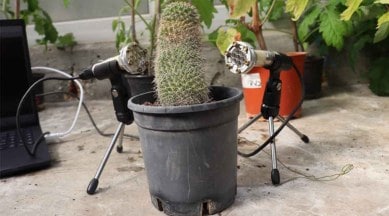Plants make sounds when they suffer but we cannot hear it
Researchers have recorded and analysed the sounds made by plants when they are in distress. Interestingly, these sounds are not too different from the sound of popping popcorn.

Researchers at Tel Aviv University have recorded and analysed sounds made by plants. The click-like noises are not too dissimilar to the sound made by the popping of popcorn.
According to the university, while the sounds are emitted at a volume similar to higher frequencies, it is emitted at high ultrasound frequencies, meaning that we cannot hear them. The research focused mainly on tomato and tobacco plants, but also included wheat, corn, cactus and henbit.
monthly limit of free stories.
with an Express account.
The researchers found that plants emit sounds when they are under stress. Not only do they make these sounds, but they make different kinds of sounds based on the kind of stress. Even though humans cannot hear this, the sounds can be heard by other animals like bats, mice and insects.
“From previous studies, we know that vibrometers attached to plants record vibrations. But do these vibrations also become airborne soundwaves – namely sounds that can be recorded from a distance? Our study addressed this question, which researchers have been debating for many years,” said Lilach Hadany, leader of the research group, in a press statement.
Hadany works at the School of Plant Sciences and Food Security at the Wise Faculty of Life Sciences at Tel Aviv University and is the corresponding author of the research article on the topic published in the journal Cell.
How the researchers “listened to plants”
For the study, the researchers placed the plants in an acoustic box inside an isolated basement that was quiet and had no background noise. They then used ultrasonic microphones that recorded frequencies between 20 to 250 kilohertz. 20 kilohertz is around the maximum frequency that can be heard by humans.
“Before placing the plants in the acoustic box, we subjected them to various treatments: some plants had not been watered for five days, in some, the stem had been cut, and some were untouched. Our intention was to test whether the plants emit sounds and whether these sounds are affected in any way by the plant’s condition,” added Hadany.
The recordings from the microphones indicated that the plants emitted frequencies that were in the range of 40 to 80 kilohertz. Unstressed plants made less than one sound per hour on average while the stressed plants emitted “dozens of sounds” every hour.
Using AI to listen to plants
The researchers then analysed these recordings using machine learning algorithms that were specially developed for the purpose. The algorithms “learned” how to differentiate between different plants and the different sounds they made.
Further, the algorithms were able to identify the plant type and level of stress from the recordings. The algorithms could even identify and classify plant sounds even when they were recorded in a greenhouse with a lot of background noise.
The researchers placed plants in the greenhouse and put them through a process of dehydration over time. They found that the quantity of the sounds emitted by the plants increased up to a certain peak before diminishing.